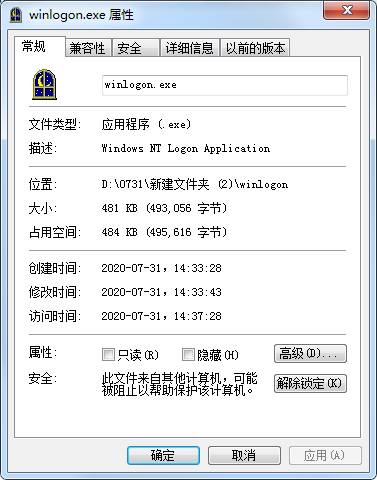- Green versionView
- Green versionView
- Green versionView
- Green versionView

winlogon.exe virus
Normal winlogon system process, its user name is "system" The program name is winlogon.exe in lower case. The user name of the Trojan horse program disguised as this process is the current system user name, and the program name is winlogon.exe in capital letters. Process viewing method ctrl+alt+del Then select the process. Under normal circumstances, there is only one winlogon.exe process, and its user name is "system". If two winlogon.exe appear, and one of them is in capital letters, and the user name is the current system user, it indicates that there may be a Trojan. This Trojan is very powerful and can destroy the Trojan star and prevent it from functioning properly. It is difficult to detect using other anti-virus software.
winlogon.exe usage instructions
-Recover files
After deleting those files, all exe files cannot be opened, nor can running cmd.exe.
The solution is to go to c:windowssystem32 , copy the cmd.exe file, for example to the desktop, rename it to cmd#com, and then double-click the com file to enter the command prompt under dos.
Enter the following command:
Assoc .exe=exefile (there is a space between assoc and .exe)
ftype exefile="%1" %*
So the exe file can be run. If you don’t know how to type commands, just open cmd#com and copy the above two lines and paste them twice to execute them.
But after doing this, it will be a little slow to enter the user when booting, and a warning box will pop up saying that file "1" cannot be found. Finally, use software such as Internet Assistant to fully repair the IE settings.
-If you still cannot execute the .exe file
The following describes how to restore the .exe file that has been tampered with.
It must be some software or even a virus that has deleted or modified the file association with the extension exe. Therefore, follow the prompts in the previous dialog box to execute the "Folder Options" command from the control panel and select the "File Types" tab. The extension "exe" and its file association cannot be found in the "Registered File Types" list. Try pressing the [New] button, enter ".exe" after "File extension", press the [Advanced] button, the system automatically defines the file type as "Application", press the [OK] button and the extension "exe" appears in the "Registered File Types" list, select it and press the [Change] button, the system asks to select the program to use, but what application should be selected to open the exe file? It seems that this method is invalid, so I have to press the [Cancel] button to return to the "Folder Options" dialog box.
Since I had never heard of establishing a file association for files with the ".exe" extension before, I selected "exe application" in the "Registered File Types" list and pressed the [Delete] button to delete it.
Since all exe files cannot be executed, I cannot use the registry editor (because I can only run regedit.exe or regedit32.exe to open the registry editor) to modify the registry. It seems that I have to restart the computer. When "Starting Windows..." appears, press the [f8] key and "Windows 2000 Advanced Options Menu", select "Last Known Good Configuration" and enter Windows The error is still reported at 2000. I had to restart again, this time selecting "Safe Mode". Although no error was reported, the exe file still could not be run. Try the "Safe mode with command line prompt" option again. After successful startup, enter: help | more ("|" is a pipe symbol, located to the left of the backspace key on the keyboard). In the first line of the information displayed by the system, I saw the following information "assoc displays or modifies file extension associations", which roughly means "assoc displays or modifies file extension associations", press any key to continue viewing, and see the following message "ftype displays or modifies file types used in file extension associations.", to the effect of "ftype displays or modifies the file types used in file extension associations." It turns out that these two special commands are hidden in the command prompt window and can be used to set file extension associations. So, enter "help" on the command line respectively. assoc" and "help ftype" two commands to obtain their usage methods, and then through the following settings, the problem of the exe file not being able to run was finally solved. To solve the problem, first enter command on the command line: assoc .exe to display exe file associations, the system displays "No file association found for extension .exe", no wonder exe files cannot be executed. Then enter: ftype | more to display all file types in the system in split screen, one of which is displayed as "exefile="%1" %*", as long as the exe file is associated with "exefile", the fault will be solved. So enter: assoc at the command line .exe=exefile (there is a space between assoc and .exe), and the screen displays ".exe=exefile". Close the command prompt window, press [ctrl+alt+del] to bring up the "Windows Security" window, press the [Shutdown] button and select the "Restart" option, and start Windows in normal mode After 2000, all exe files can run normally.
winlogon.exe update log
1. The details are more outstanding!
2.BUG gone without a trace
Huajun editor recommends:
winlogon.exe can help you solve many problems. I believe that as long as you dare to use it, you will definitely not be able to put it down. I also recommend it to you.Batch Butler,Cloud Machine Manager,Hard drive serial number reader,Quickly hide taskbar icon tool,Android Emulator Master



































Useful
Useful
Useful